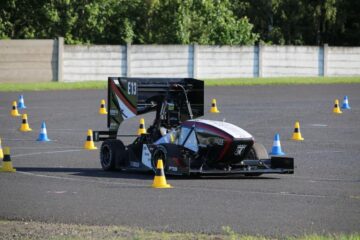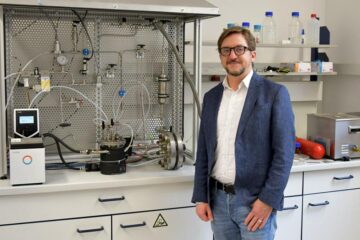First light: APEX liefert erste Daten

APEX (Atacama Pathfinder Experiment), das leistungsfähigste erdgebundene Instrument zur Erforschung der Sternentstehung hat nach rund 36 Monaten Bauzeit unter den klimatisch extremen Bedingungen der 5100 Meter hoch gelegenen Atacamawüste erste Daten geliefert. Sie beweisen, dass das Teleskop eine nahezu ungehinderte Sicht auf Sternentstehungsgebiete und Galaxienkerne ermöglicht.
Aus diesem Anlass laden wir Sie herzlich ein zu einem Hintergrundgespräch
am 14. Juli 2005, 11:00 – 16:00
im Max-Planck-Institut für Radioastronomie
Auf dem Hügel 69, 53121 Bonn
Das APEX-Teleskop entstand in einer internationalen Zusammenarbeit unter Leitung von Prof. Dr. Karl Menten, Direktor am Bonner Max-Planck-Institut für Radioastronomie. Von APEX erwartet man
· entscheidende Fortschritte insbesondere zum Verständnis des frühen Universums und der Prozesse der Galaxien- und Sternentstehung,
· die weitere Erforschung des Südhimmels im bisher wenige erschlossenen Submillimeter-Bereich und
· weiträumige Beobachtungen, die als Vorstudien (Pfadfinder) für spätere detaillierte Arbeiten am Atacama Large Millimeter Array (ALMA) dienen werden.
Finanziert wird das APEX-Projekt durch das Max-Planck-Institut für Radioastronomie, die Europäische Südsternwarte (ESO) und das Onsala Space Observatory (OSO). Die drei Partner teilen sich auch die Beobachtungszeit, während 10% der Beobachtungszeit für chilenische Astronomen zur Verfügung stehen wird.
Abbildungen und Footage stellen wir kostenfrei zur Verfügung.
Programm
11:00 Welcome Prof Dr Karl M. Menten Director Max Planck Institute for Radio Astronomy
11:05 Introduction of the APEX Consortium
Prof Dr Roy Booth, Onsala Space Observatory (OSO)
Dr Ian Corbett, European Southern Observatory (ESO)
Prof Dr Karl Menten, Max Planck Institute for Radio Astronomy
11:20 Submm astronomy & science perspectives with APEX Prof Dr Karl M. Menten Director Max Planck Institute for Radio Astronomy
11:50 Project Overview
– Introduction & Status of the Project: Dr Rolf Güsten
Projektmanager APEX (MPIfR)
– Infrastructure, Logistics, Operation: Dr. Lars-A. Nyman
Head of APEX Station
12:15 Design and Construction of the telescope
Dr Karl-Heinz Stenvers, Director VERTEX Antennentechnik
Dr. Konrad Pausch, Technical Director VERTEX Antennentechnik
12:35 Commissioning of the Telescope
Dr Rolf Güsten
12:55 — Lunch Break —
13:45 Instrumentation for APEX (moderation: Dr Rolf Güsten)
Detector instruments for submillimeter telescopes fall into two broad categories: heterodyne and bolometric receivers. Heterodyne receivers allow splitting of the radiation into fine frequency intervals, creating spectra. Analysis of such spectra (spectroscopy) allows determination of the physical properties and chemical content of interstellar molecular clouds within and outside of our Galaxy.
Bolometers on the other hand, have very broad bandwidth and are thus extremely sensitive. Recent developments allow packaging of detectors into arrays, similar to the CCD array in your digital camera.
APEX will be equipped with both, bolometer and heterodyne arrays which, including the necessary readout electronics, are developed by the MPIfR and OSO, in some cases in collaboration with other partners.
Selected presentations by APEX instrument scientists will give an overview of APEX detectors and detector arrays – present and future.
14:15 First-light science results (moderation: Prof Dr Karl Menten)
A variety of scientific results have been obtained with APEX in the first few weeks of its operation. These include measurements of molecules in the immediate vicinity of hot massive very young stars, the central regions of galaxies containing active nuclei and the Magellanic Clouds, our nearest neighbour galaxies. Since these wavelengths have never before been explored with a similar telescope in the southern hemisphere, many of these results are genuine „firsts“.
APEX scientists will present assorted first-light results.
15:00 Plans for the near future (2005/2006):
In a collaboration with the University of California at Berkeley and Bonn University an extremely sensitive survey for distortions in the spectrum of the cosmological microwave background radiation by the hot plasma of clusters of galaxies (the „Sunyaev-Zeldovich-Effekt“) will be conducted, revealing thousands of galaxy clusters, placing constraints on the cosmological parameters, Dark Energy and structure formation in the Universe.
In a systematic survey of our Milky Way galaxy’s plane we shall detect gas condensations harbouring newly-formed stars or protostars with masses as little as one solar mass at distances of thousands of light years.
Innovative receivers on the superb Atacama site will allow the first ground-based explorations of the few atmospheric „windows“ beyond one Terahertz (wavelengths shorter than 300 micrometers). Such receivers are currently developed for APEX at OSO, the University at Cologne, and the Harvard-Smithsonian Center for Astrophysics.
As it name says, APEX is the pathfinder for other (sub)mm wavelength projects, most directly for the Atacama Large Millimeter Array (ALMA) – an interferometric array of dozens of submillimeter telescopes (of which APEX is actually one of the prototypes). There also is great complementarity to the Herschel Satellite (the 4th cornerstone in ESA’s „Horizons 2000“ program) and the Stratospheric Observatory for Infrared Wavelegths (SOFIA). Herschel’s HIFI instrument overlaps with APEX’s frequency range but also covers the large parts of the spectrum unaccessible to APEX because of atmospheric absorption. Herschel, like SOFIA, reaches to higher frequencies into the infrared range. The MPIfR Submillimeter Technology divison also builds instrumentation for HIFI and SOFIA.
A final presentation will summarize these exciting perspectives.
15:30 General Discussion
Weitere Informationen und Anmeldung:
Susanne Milde
Milde Marketing Wissenschaftskommunikation
Tel.: 0049 331 721 53 71
Fax: 0049 331 721 53 80
www.milde-marketing.de
Antwort bitte zurückfaxen an: 0331 – 721 53 80
? Ich kann am Pressetermin teilnehmen.
? Ich kann am Pressetermin nicht teilnehmen.
? Bitte schicken Sie mir Hintergrundinformationen.
Name: _______________________________
Redaktion: __________________________
Tel./Fax.: __________________________
email: ______________________________
Media Contact
Weitere Informationen:
http://www.mpg.de/Alle Nachrichten aus der Kategorie: Physik Astronomie
Von grundlegenden Gesetzen der Natur, ihre elementaren Bausteine und deren Wechselwirkungen, den Eigenschaften und dem Verhalten von Materie über Felder in Raum und Zeit bis hin zur Struktur von Raum und Zeit selbst.
Der innovations report bietet Ihnen hierzu interessante Berichte und Artikel, unter anderem zu den Teilbereichen: Astrophysik, Lasertechnologie, Kernphysik, Quantenphysik, Nanotechnologie, Teilchenphysik, Festkörperphysik, Mars, Venus, und Hubble.
Neueste Beiträge

Ideen für die Zukunft
TU Berlin präsentiert sich vom 22. bis 26. April 2024 mit neun Projekten auf der Hannover Messe 2024. Die HANNOVER MESSE gilt als die Weltleitmesse der Industrie. Ihr diesjähriger Schwerpunkt…

Peptide auf interstellarem Eis
Dass einfache Peptide auf kosmischen Staubkörnern entstehen können, wurde vom Forschungsteam um Dr. Serge Krasnokutski vom Astrophysikalischen Labor des Max-Planck-Instituts für Astronomie an der Universität Jena bereits gezeigt. Bisher ging…

Wasserstoff-Produktion in der heimischen Garage
Forschungsteam der Frankfurt UAS entwickelt Prototyp für Privathaushalte: Förderzusage vom Land Hessen für 2. Projektphase. Wasserstoff als Energieträger der Zukunft ist nicht frei verfügbar, sondern muss aufwendig hergestellt werden. Das…





















